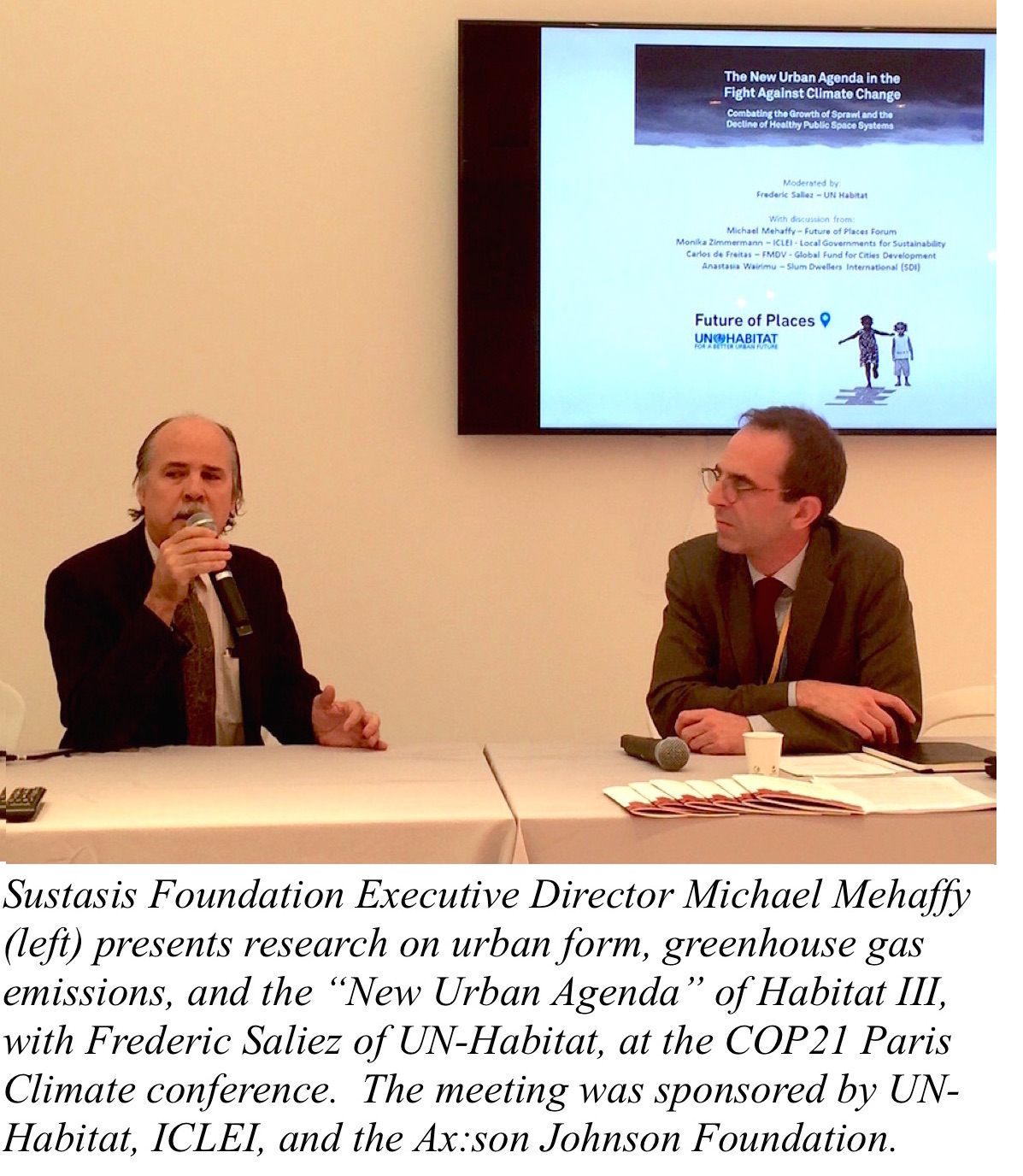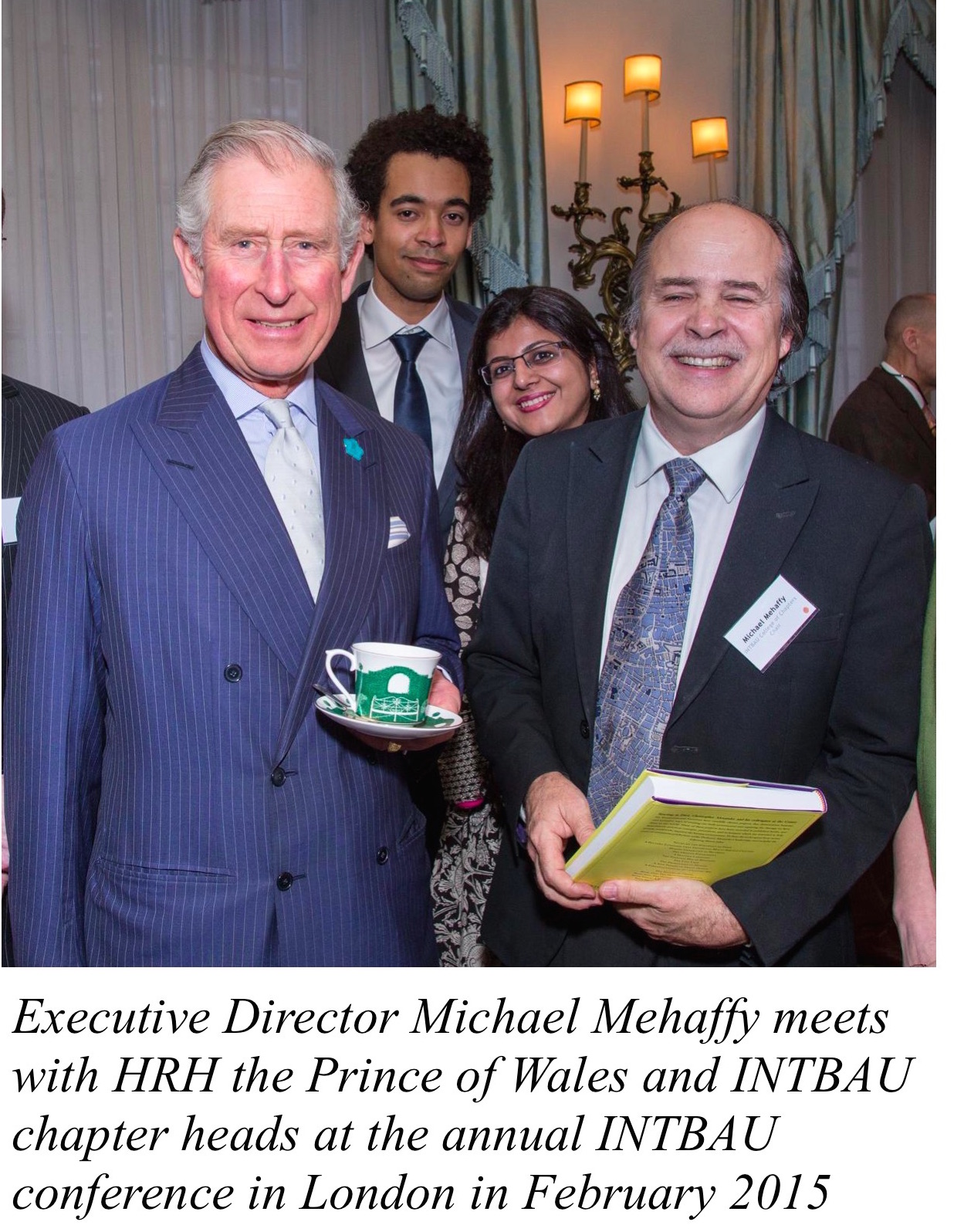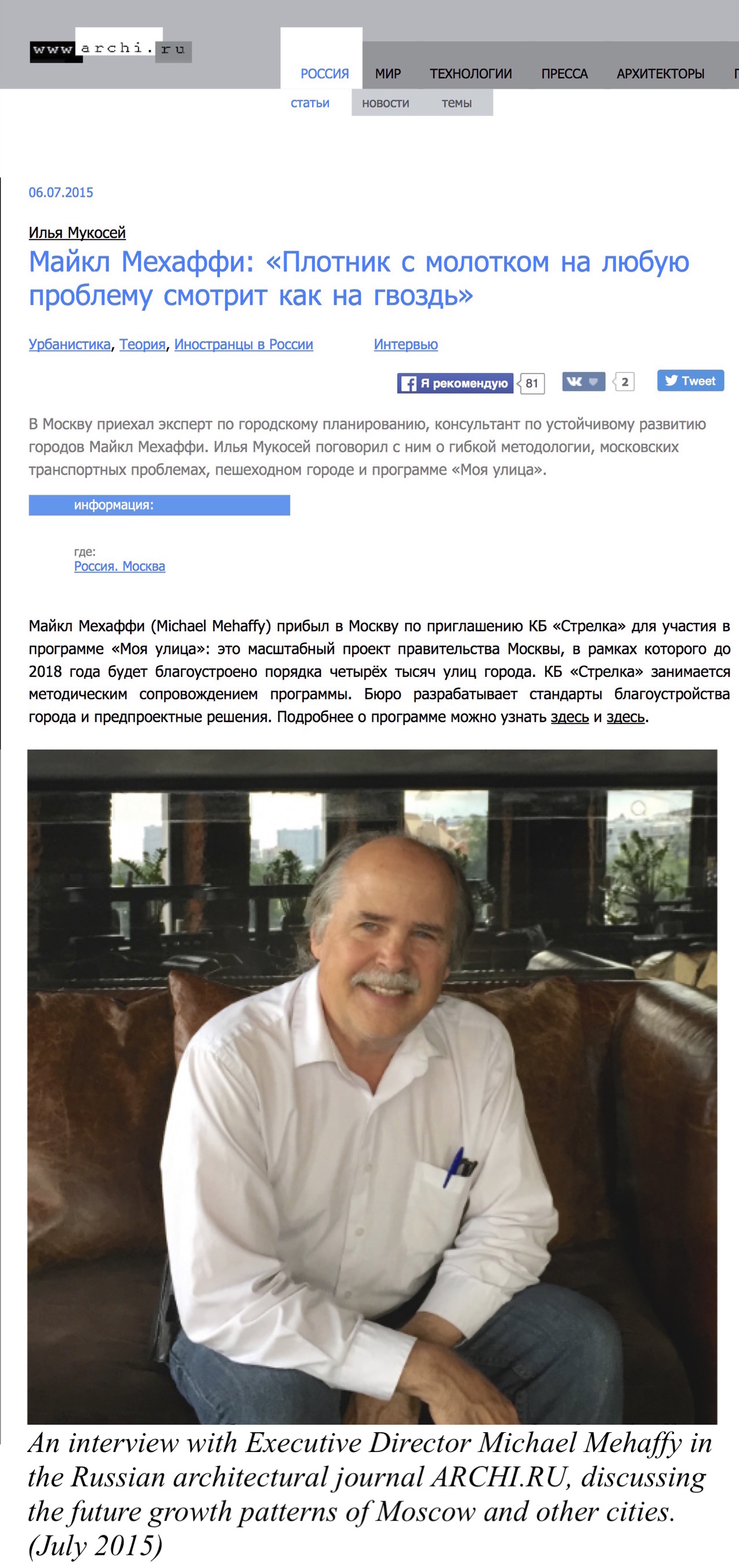
Overview
of 2015 Activities
By Michael Mehaffy, Executive Director
 This
is a crucial time in the history of global urban development. The
world is urbanizing, at a pace that is unrivaled in human history
-- and
the models being used are still, for the most part, the same ones that
have failed us in the last half-century: sprawling, resource-intensive,
functionally and socially segregated, and treating cities as a kind of
sculpture gallery of fragmented, poorly adapted object-buildings.
This model is, in a word, unsustainable. If we are going to meet the great challenges of the next century and beyond, it is urgent that we take forward effective reforms immediately.
This
is a crucial time in the history of global urban development. The
world is urbanizing, at a pace that is unrivaled in human history
-- and
the models being used are still, for the most part, the same ones that
have failed us in the last half-century: sprawling, resource-intensive,
functionally and socially segregated, and treating cities as a kind of
sculpture gallery of fragmented, poorly adapted object-buildings.
This model is, in a word, unsustainable. If we are going to meet the great challenges of the next century and beyond, it is urgent that we take forward effective reforms immediately.
The evidence shows that cities do have an enormous capacity to support
positive human development and flourishing, with great efficiency -- IF
their structure provides for that open, dynamic capacity. New research
is pointing the way to a better understanding of the needed
structure. In the process, we are re-learning age-old lessons
about the role of public space, as a kind of "spine" of the city, and
the scale and character of the most successful urban spaces. This "science of cities" is emerging and coalescing
to provide tangible best-practice lessons, in place of the failing
models we have been using.
We need to build on these hopeful models, use them to replace
the failing, ultimately catastrophic models that are still being used
today. But much work remains toward this essential goal. This is, in essence, at the core of the mission of the
Sustasis Foundation.
COP21
We recently completed research at Delft University of Technology on sustainable urban form, and
specifically, urban form that aids in reducing greenhouse gas emissions
per person (as evidence clearly demonstrates is possible). We
presented this research at the climate change summit in Paris, COP21,
in an event in partnership with UN-Habitat, ICLEI, and the Ax:son
Johnson Foundation.
This continues our work with UN-Habitat on what they are calling
the "New Urban Agenda," and the new models that are necessary to avert
planetary threats to human well-being,
including resource depletion, toxic emissions, ecological destruction,
and the potentially catastrophic effects of climate change.
 Michael Mehaffy, our executive director, led a “consultation” for
Habitat III at the UN in New York in September 2014, followed by his
participation in PrepCom2, a meeting of the preparatory planning
committee, in Nairobi, Kenya. In June he chaired the academic
research session at the Future of Places forum, which also fed into
Habitat III planning. In September he attended a meeting in
New York hosted by the Ford Foundation and Rockefeller Foundation, on the United Nations Summit to Adopt the Post-2015 Development Agenda.
This is described as and event that “will set the course for tackling
the world’s social, environmental, and economic challenges in the years
to come.”
Michael Mehaffy, our executive director, led a “consultation” for
Habitat III at the UN in New York in September 2014, followed by his
participation in PrepCom2, a meeting of the preparatory planning
committee, in Nairobi, Kenya. In June he chaired the academic
research session at the Future of Places forum, which also fed into
Habitat III planning. In September he attended a meeting in
New York hosted by the Ford Foundation and Rockefeller Foundation, on the United Nations Summit to Adopt the Post-2015 Development Agenda.
This is described as and event that “will set the course for tackling
the world’s social, environmental, and economic challenges in the years
to come.”
These are examples of the fruits of partnerships between Sustasis and
its Executive Director, and other, much larger and more influential
partners including the Ax:son Johnson Foundation, UN-Habitat, ICLEI,
INTBAU, CEU (see below) and others. Working with key partners who are
sympathetic, and to whom we can provide some "value added" from oour
own work, we can be far more effective in addressing the challenges of
our time than might be expected from our very modest size.
NOT JUST POLICY CHANGES - ALSO NEW TOOLS AND RESOURCES
We believe it is important to provide not only new insights and
models, but new concrete tools to allow practitioners to change the
outcomes of their work. In essence, we must change the rules and
procedures that shape the "operating system for growth" -- and that
currently reinforce, and "lock in", unsustainable practices.
 To that end, we also continued development of our other key initiatives on pattern
languages and wiki, including the new Federated Wiki structure.
(Board member Ward Cunningham, the inventor of wiki, is developing the
new Wiki with collaboration by us and others.) Executive Director
Michael Mehaffy has completed a book, the text of his Ph.D.
dissertation, which includes a new community planning tool based on
the new Federated Wiki. This tool is now ready for "beta-testing" within a community planning process.
To that end, we also continued development of our other key initiatives on pattern
languages and wiki, including the new Federated Wiki structure.
(Board member Ward Cunningham, the inventor of wiki, is developing the
new Wiki with collaboration by us and others.) Executive Director
Michael Mehaffy has completed a book, the text of his Ph.D.
dissertation, which includes a new community planning tool based on
the new Federated Wiki. This tool is now ready for "beta-testing" within a community planning process.
More broadly, this work is part of a promising initiative to revive the
use of "pattern languages" -- Christopher Alexander's celebrated
innovation that has found wide acceptance in software and other fields
-- in the realm of the built environment, where pattern languages have
been somewhat limited to the very famous book by that name. Our
aim is to take them "open source," a strategy that has proven brilliant
in Wiki and other major innovations. (Wiki, in fact, was
developed directly out of work with pattern languages by our board
member Ward Cunningham.)
We also continued to develop our collaborative relationship with
the International Network for Traditional Building, Architecture and
Urbanism (a London-based NGO for sustainable development and
regeneration, whose patron is HRH the Prince of Wales). This year
Michael Mehaffy, our Executive Director, addressed the INTBAU World Congress, followed by a meeting with HRH
the Prince of Wales to discuss additional ongoing initiatives. Sustasis
hosts the US chapter of INTBAU as a registered non-profit US and Oregon corporation.
We also continued our collaborations with colleagues in Europe, South
America, the USA and elsewhere, including our hosting of the research
coordination network, the Environmental Structure Research Group
(ESRG), which was formed in 2006 and has member colleagues in Europe,
Asia, North and South America. We are exploring ways of making
better use of this promising resource, perhaps through a new research
center which will likely be formed in the first months of the new year
by our close partners. We hope to have an announcement soon!
A CITY IS NOT A TREE, 50TH ANNIVERSARY EDITION
The last project on our schedule for this year is one of the most
important: a 50th anniversary edition of Christopher Alexander's
seminal 1965 paper, "A City is Not a Tree." This paper set the
stage for all of Alexander's work afterwards, and it inspired a
generation of urban and architectural theorists, as our authors
attest. The new volume features the original essay, together with
contemporary commentaries by leading researchers and practitioners, as
well as a more recent dialogue with Alexander on the topics covered.
The volume will be invaluable as a study resource for students, and a needed provocation to current practitioners.
This project is now going into production and we greatly appreciate
donations to support this very important work. More information
is available on this information page.
New Resources
• Book, Design for a Living Planet, Michael Mehaffy and Nikos Salingaros (published January 2015).
• Book, Urban Form and Greenhouse Gas Emissions: Findings,
Strategies, Design Decision Support Technologies. Delft
University of Technology Press. (Ph.D. dissertation, published
simultaneously as a book.)
• Book, A City is Not a Tree, 50th Anniversary Edition. New (and very timely) publication Christopher Alexander's landmark publication, together with
interpretive essays by contemporary authors. An indispensable resource for students and professionals. (Forthcoming.)
• White Paper, “The Impacts of Tall Buildings: A Research Summary,” on Sustasis website.
• White Paper, “Valuing the Benefits of Public Space Systems,” on Sustasis website.
• Essay, “What we didn't learn from Katrina,” on Planetizen.com
Speaking and Other Collaborations for Conferences, Symposia and Meetings
(By Executive Director Michael Mehaffy, unless otherwise noted)
• “INTBAU: A global network to build on humane, people-centered
architecture and urbanism.” Presentation, moderation and panel
discussion at INTBAU World Conference, London (February).
• Testimony before the Portland City Council, discussing research on tall buildings. (February.)
• TradArch Conference, Charleston, SC., co-planned, paticipated, and
developed INTBAU networks. Met with Colby Broadwater of the
American College of Building Arts, and laid the framework for a
partnership with INTBAU. (March.)
• “The importance of pubic space in rapidly urbanizing cities.”
Presentation at PrepCom2, preparatory meeting for Habitat III.
(April)
• “The UrbanLex Database and the need to reform laws around public
space.” Presentation at PrepCom2, preparatory meeting for Habitat
III. (April)
• “Design for a Rapidly Urbanizing Planet,” presentation and session moderation at Congress for the New Urbanism (May).
• “The 'Place' of Art”. Lecture and panel discussion at “New
Urbanism and the Human Habitat: Beauty in the Natural and Built
Environment.” National Civic Art Society, Washington D.C. (May)
• “Toward a New 'Culture of Building'”. Presentation and
discussion at International Trades Education Symposium, Savannah,
GA. Concluded a partnership agreement with the Savannah Technical
College's program in building arts. (May)

• “The Structure of Healthy Streets and Public Spaces,” Presentation to Strelka Institute, Moscow RU. (June)
• “The Structure of Public Space Networks, and Why it is Critical,”
report and discussion of research for the Future of Places Forum,
Stockholm SE (June).
• “Place Network Theory: Towards Healthy, Sustainable Streets and
Public Spaces.” International Making Cities Livable, Bristol, UK (July).
• “Philanthropy Engaged,” discussions at side meeting of UN Sustainable
Development Summit, on implementation networks to take forward the
sustainable developmen goals (September).
• “The Architecture of Livable Neighborhoods, “presentation at Center
for Advanced Research in Traditional Architecture, conference on
“Designing a Better Future,” Denver, CO (October).
• “Infill Construction in Historic Settings: Character, Identity and
Materials,” presentation and moderation, Traditional Building Expositon
and Conference, Denver, CO (October).
• “Lessons from Portland: Orenco Station and Beyond,” keynote
presentation at annual conference of Association du Transport Urbain du
Quebec, Quebec City, QU (October)
• Meeting and presentation, roundtable of regional planners, Communauté
Métropolitaine de Montreal, Montreal, QU (October)
• “INTBAU and the 'New Urban Agenda,'” presentation to annual
conference of International Network of Traditional Building,
Architecture and Urbanism, Havana, Cuba (November)
• “Defining the 'New Urban Agenda' for COP21 Annd Beyond,” Keynote
presentation at annual conference of Council for European Urbanism,
Berlin DE (November)
• “Urban form and Greenhouse Gas Emissions,” public presentation of research at Delft University of Technology, NL (November)
• “The New Urban Agenda in the Fight Against Climate Change: Combating
the Growth of Sprawl and the Decline of Healthy Public Space Systems,”
keynote presentation at COP21 session, co-hosted by UN-Habitat, ICLEI,
and Ax:son Johnson Foundation, Paris, FR (December)
Planning Consultations
• Habitat III, preparatory event planning conference committee meeting, PrepCom2 (April)
• Street development policy and new code, for Strelka Institute and City of Moscow, Russian Republic (June-July)
• Strategic planning of transit-oriented developments, with roundtable
of regional planners, Communauté Métropolitaine de Montreal, Montreal,
QU (October)
• Development of Vista Field, a project for the Port of Kennewick,
Washington using a project pattern language (collaboration with DPZ
Partners).
We welcome your questions, comments, or proposals for collaboration – and as always, we are grateful for support in all forms!
Dr. Michael Mehaffy
Executive Director


 This
is a crucial time in the history of global urban development. The
world is urbanizing, at a pace that is unrivaled in human history
-- and
the models being used are still, for the most part, the same ones that
have failed us in the last half-century: sprawling, resource-intensive,
functionally and socially segregated, and treating cities as a kind of
sculpture gallery of fragmented, poorly adapted object-buildings.
This model is, in a word, unsustainable. If we are going to meet the great challenges of the next century and beyond, it is urgent that we take forward effective reforms immediately.
This
is a crucial time in the history of global urban development. The
world is urbanizing, at a pace that is unrivaled in human history
-- and
the models being used are still, for the most part, the same ones that
have failed us in the last half-century: sprawling, resource-intensive,
functionally and socially segregated, and treating cities as a kind of
sculpture gallery of fragmented, poorly adapted object-buildings.
This model is, in a word, unsustainable. If we are going to meet the great challenges of the next century and beyond, it is urgent that we take forward effective reforms immediately. Michael Mehaffy, our executive director, led a “consultation” for
Habitat III at the UN in New York in September 2014, followed by his
participation in PrepCom2, a meeting of the preparatory planning
committee, in Nairobi, Kenya. In June he chaired the academic
research session at the Future of Places forum, which also fed into
Habitat III planning. In September he attended a meeting in
New York hosted by the Ford Foundation and Rockefeller Foundation, on the United Nations Summit to Adopt the Post-2015 Development Agenda.
This is described as and event that “will set the course for tackling
the world’s social, environmental, and economic challenges in the years
to come.”
Michael Mehaffy, our executive director, led a “consultation” for
Habitat III at the UN in New York in September 2014, followed by his
participation in PrepCom2, a meeting of the preparatory planning
committee, in Nairobi, Kenya. In June he chaired the academic
research session at the Future of Places forum, which also fed into
Habitat III planning. In September he attended a meeting in
New York hosted by the Ford Foundation and Rockefeller Foundation, on the United Nations Summit to Adopt the Post-2015 Development Agenda.
This is described as and event that “will set the course for tackling
the world’s social, environmental, and economic challenges in the years
to come.”  To that end, we also continued development of our other key initiatives on pattern
languages and wiki, including the new Federated Wiki structure.
(Board member Ward Cunningham, the inventor of wiki, is developing the
new Wiki with collaboration by us and others.) Executive Director
Michael Mehaffy has completed a book, the text of his Ph.D.
dissertation, which includes a new community planning tool based on
the new Federated Wiki. This tool is now ready for "beta-testing" within a community planning process.
To that end, we also continued development of our other key initiatives on pattern
languages and wiki, including the new Federated Wiki structure.
(Board member Ward Cunningham, the inventor of wiki, is developing the
new Wiki with collaboration by us and others.) Executive Director
Michael Mehaffy has completed a book, the text of his Ph.D.
dissertation, which includes a new community planning tool based on
the new Federated Wiki. This tool is now ready for "beta-testing" within a community planning process.